
Taavetti Fortress (Finnish : Taavetin linnoitus), is a fortress located in Taavetti in the municipality of Luumäki in Finland. [1]

Taavetti Fortress (Finnish : Taavetin linnoitus), is a fortress located in Taavetti in the municipality of Luumäki in Finland. [1]
Taavetti Fortress was built at a strategically important road junction at the southern end of the Salpausselkä. The walls of the fortress give it an almost circular shape.This Fortress is part of the southeastern Finnish fortification system built by Russia after the Russo-Swedish War of 1788–1790. [2]

During the first phase of construction which extends from 1773 to 1781, a fortress is built consisting of ramparts, measuring approximately 650 x 800 meters. During the second phase of construction from 1791 to 1796, the interior buildings of the fortress were raised. Military use of the fortress ceased in 1803 before the war in Finland.
The ruins of the fortress were restored in the 1980s and open-air events are held here.
The Finnish Heritage Agency has listed Taavetti Fortress as a Built Cultural Site of National Interest in Finland. [3]

Helsinki is the capital and most populous city in Finland. It is on the shore of the Gulf of Finland and is the seat of southern Finland's Uusimaa region. About 682,000 people live in the municipality, with 1.26 million in the capital region and 1.6 million in the metropolitan area. As the most populous urban area in Finland, it is the country's most significant centre for politics, education, finance, culture, and research. Helsinki is 80 kilometres (50 mi) north of Tallinn, Estonia, 360 kilometres (220 mi) north of Riga, Latvia, 400 kilometres (250 mi) east of Stockholm, Sweden, and 300 kilometres (190 mi) west of Saint Petersburg, Russia. Helsinki has significant historical connections with these four cities.

Suomenlinna, or Sveaborg, is a sea fortress composed of eight islands, of which six have been fortified; it is about 4 km southeast of the city center of Helsinki, the capital of Finland. Suomenlinna is popular with tourists and locals, who enjoy it as a picturesque picnic site. Originally named Sveaborg, or Viapori as referred to by Finnish-speaking Finns, it was renamed in Finnish to Suomenlinna in 1918 for patriotic and nationalistic reasons, though it is still known by its original name in Sweden and by Swedish-speaking Finns. Due to its strategic geographical location, it sometimes used to be known as Gibraltar of the North.
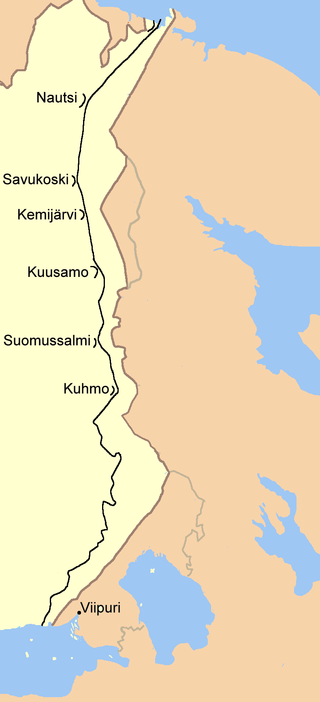
The Salpa Line, or its official name, Suomen Salpa, is a bunker line on the eastern border of Finland. It was built in 1940–1941 during the Interim Peace between the Winter War and the Continuation War and further in 1944 to defend Finland against a possible Soviet invasion.
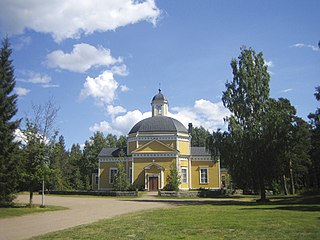
Luumäki is a municipality of Finland. Its seat is in the Taavetti village. It is located in the province of Southern Finland and is part of the South Karelia region. The municipality has a population of 4,377 (31 August 2024) and covers an area of 859.83 square kilometres (331.98 sq mi) of which 109.77 km2 (42.38 sq mi) is water. The population density is 5.83 inhabitants per square kilometre (15.1/sq mi). The municipality is unilingually Finnish.

Helsingin Jalkapalloklubi, commonly known as HJK Helsinki, or simply as HJK, is a Finnish football club based in Helsinki. The club competes in Veikkausliiga, the top division of the Finnish football league system. Founded in 1907, the club has spent most of its history in the top tier of Finnish football. The club's home ground is the 10,770-seat Bolt Arena, where they have played their home games since 2000.

Littoinen (Finnish; Littois

Didrichsen Art Museum is an art museum in Helsinki, Finland.

The Krepost Sveaborg was an Imperial Russian system of land and coastal fortifications constructed around Helsinki during the First World War. The purpose of the fortress was to provide a secure naval base for the Russian Baltic fleet and to protect Helsinki and block routes to Saint Petersburg from a possible German invasion. Krepost Sveaborg was part of Peter the Great's Naval Fortress, a coastal fortification system protecting access to Saint Petersburg by sea. The central part of Krepost Sveaborg was the old fortress of Suomenlinna where the fortress headquarters were located. Due to technological advances in artillery the old fortress was no longer capable of providing a sufficient protection, and a new main defensive line was built well beyond the old fortress boundaries. New coastal artillery guns built on outlying islands protected Krepost Sveaborg from the sea, while fortified lines constructed around Helsinki were intended to stop any attacks on land. The primary coastal guns were 10 in (254 mm) model 1891 guns and 6 in (152 mm) model 1892 Canet guns. Older 11 in (279 mm) model 1877 guns were also used. In summer 1917 the fortress had two hundred coastal or anti-landing guns, of which 24 were 10-inch guns in six batteries, 16 were 6-inch Canet guns in four batteries and twelve were 11-inch guns in three batteries. The artillery used in land fortifications included older coastal guns, old fixed carriage guns and newer light field guns. In March 1917, Krepost Sveaborg had a total of 463 guns, although many of them were obsolescent. Krepost Sveaborg was still partly incomplete in 1917 when the February Revolution halted most of the construction work. Some further construction work was carried out during the remaining year, but all work halted during the October Revolution. Following the Finnish Declaration of Independence, parts of the land fortifications were used in the Finnish Civil War. The coastal fortifications were later taken over by Finland to protect Helsinki, while the land fortifications were mostly abandoned and disarmed.
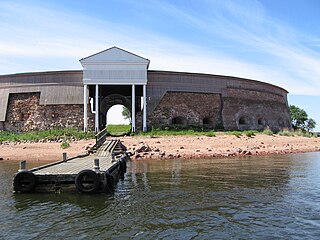
Ruotsinsalmi sea fortress is a fortification system in Kotka, Finland. It is part of the South-Eastern Finland fortification system built by Russia after Russo-Swedish War of 1788-1790. Ruotsinsalmi sea fortress formed the southern part of a double fortress together with Kyminlinna and it was built to counter the Swedish sea fortresses of Svartholm in Loviisa and Sveaborg (Suomenlinna) in Helsinki. Ruotsinsalmi also acted as an outpost of the Kronstadt sea fortress in Saint Petersburg. During the Crimean War, a British-French fleet destroyed the Ruotsinsalmi fortifications in 1855.

South-Eastern Finland fortification system is an extensive defensive system formed by three concentric fortress chains in South-East Finland built by Russia in the 1790s. The purpose of the fortification system was to protect the capital of the Russian Empire, Saint Petersburg, from a possible Swedish attack.

The international border between Finland and Russia is 1,340 km (830 mi) long and runs approximately north to south, mostly through taiga forests and sparsely populated rural areas. It does not follow any natural landmarks, such as mountains or rivers. It is also an external border of the European Union and NATO.
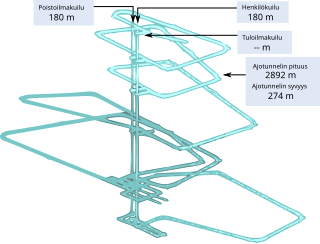
The Onkalo spent nuclear fuel repository is a deep geological repository for the final disposal of spent nuclear fuel. It is near the Olkiluoto Nuclear Power Plant in the municipality of Eurajoki, on the west coast of Finland. It will be the world's first long-term disposal facility for spent nuclear fuel. It is being constructed by Posiva, and is based on the KBS-3 method of nuclear waste burial developed in Sweden by Svensk Kärnbränslehantering AB (SKB). The facility will be operational by 2026, and decommissioned by 2100.
Daavid (Taavetti) Latveteläinen was a Finnish construction worker and politician. He was born in Maaninka and was a member of the Parliament of Finland from 1911 to 1918, representing the Social Democratic Party of Finland (SDP). During the Finnish Civil War Lapveteläinen was a member of the Central Workers' Council. He was imprisoned after the war and died in detention in 1919. He died in Helsinki.

Trångsund Fortress is a naval fort by the Vyborg Bay in the town of Vysotsk, Leningrad Oblast, Russia. It was established by Peter the Great in 1710 to secure the town of Vyborg which was captured from Sweden during the Great Northern War.

Utti Fortress is a bastion fortress in Utti, Finland. It was built in 1790s as a part of a larger South-Eastern Finland fortification system to protect Saint Petersburg, the capital of Russian Empire.

Liikkala Fortress is a fortress in Kouvola, Finland. It was built in 1790s as a part of a larger South-Eastern Finland fortification system to protect Saint Petersburg, the capital of the Russian Empire.

The Hikiä railway station is located in Hausjärvi, Finland, in the village and urban area of Hikiä. It is located along the Riihimäki–Lahti line, and its neighboring stations are Riihimäki in the west and Oitti in the east.
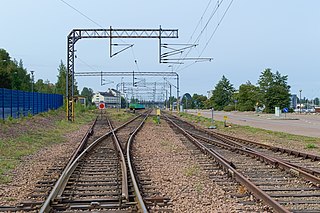
The Kouvola–Kotka railway, also called the Kotka railway is a 1,524 mm railway in Finland, connecting the towns of Kouvola and Kotka in the region of Kymenlaakso.
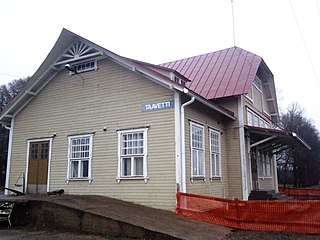
Taavetti is a village and administrative center of the Luumäki municipality in South Karelia, Finland. It has a population of 2,084. It is located along Highway 6 between Lappeenranta and Kouvola, and its center also runs on Highway 26 towards Hamina. The distance from Taavetti to the nearest city, Lappeenranta, is about 40 kilometres (25 mi).

Hanko Fortress was a fortress built in Hanko at the end of the 18th century, which consisted of the Gustavsvärn, Meijerfeldt and Gustaf Adolf fortresses built on rock outcrops, and the Kuningattarenvuori fortresses located on the mainland. The island fortresses formed a triangle that protected the sea channel leading to the port of Hanko.